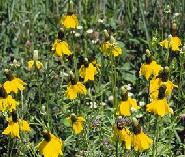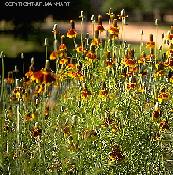
Photo by Kurt Adolfson

Photo by Kurt Adolfson
A perennial about a foot and a half tall with several stems usually grow from the crown of a taproot. Leaves about three inches long are divided into five to nine narrow leaflets. The flower heads consist of several hundred tiny purplish-brown flowers while at the bottom of the cylinder there are about a half-dozen bright yellow rays about an inch long. It grows in dry, open places, such as along roadsides up to elevations of 7,000.. It flowers throughout the summer and is found widespread throughout southern Idaho..
Food Use:
A pleasant tasting tea is made from the leaves and flower heads.
Medicine:
The leaves and stems are analgesic. An infusion is used to
relieve the pain of headaches and to treat stomach aches and fevers. A decoction
is used as a wash to relieve pain and to treat poison ivy rash[. The decoction
is also used as a wash to draw the poison out of a rattlesnakes bite.
Planting:
Prefers a sunny well-drained border of fairly rich soil[1].
Established plants are extremely drought tolerant. Division in spring is
possible but very difficult because the plant has a long taproot.
